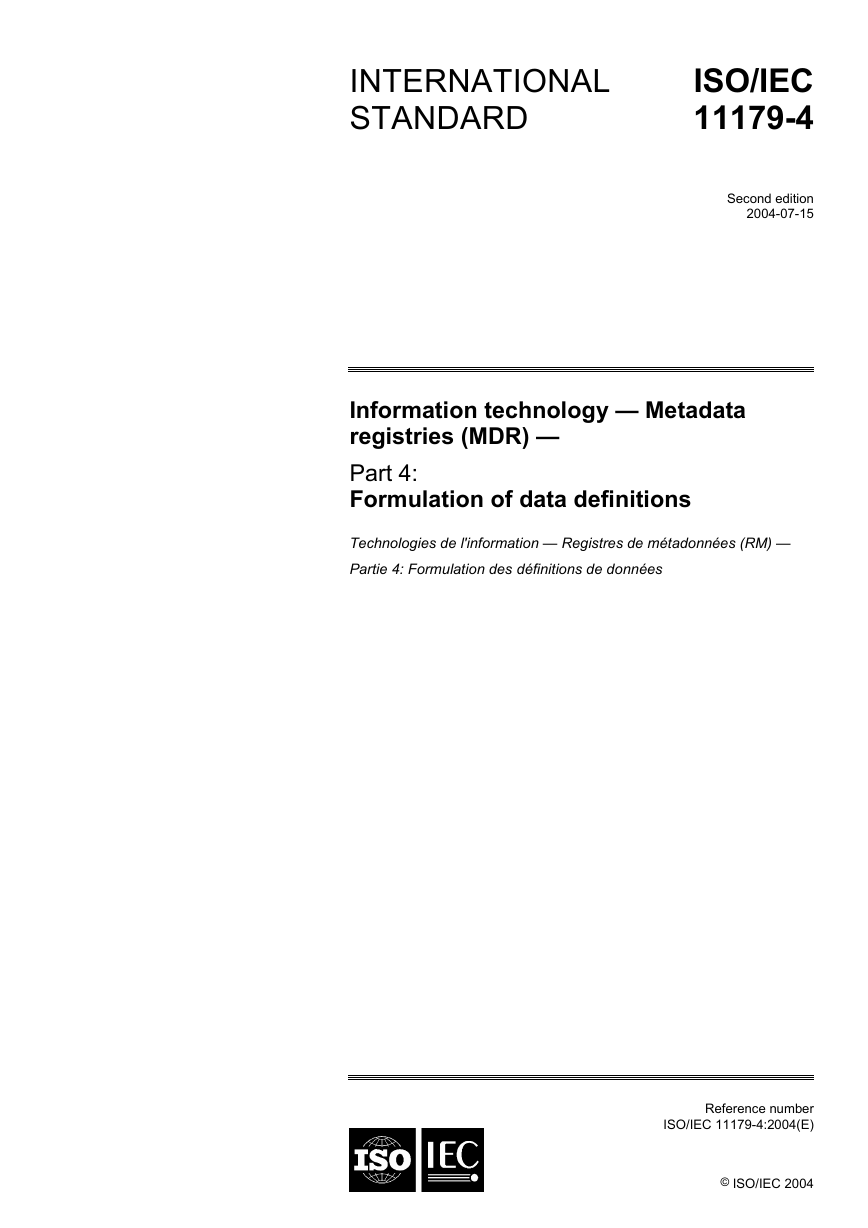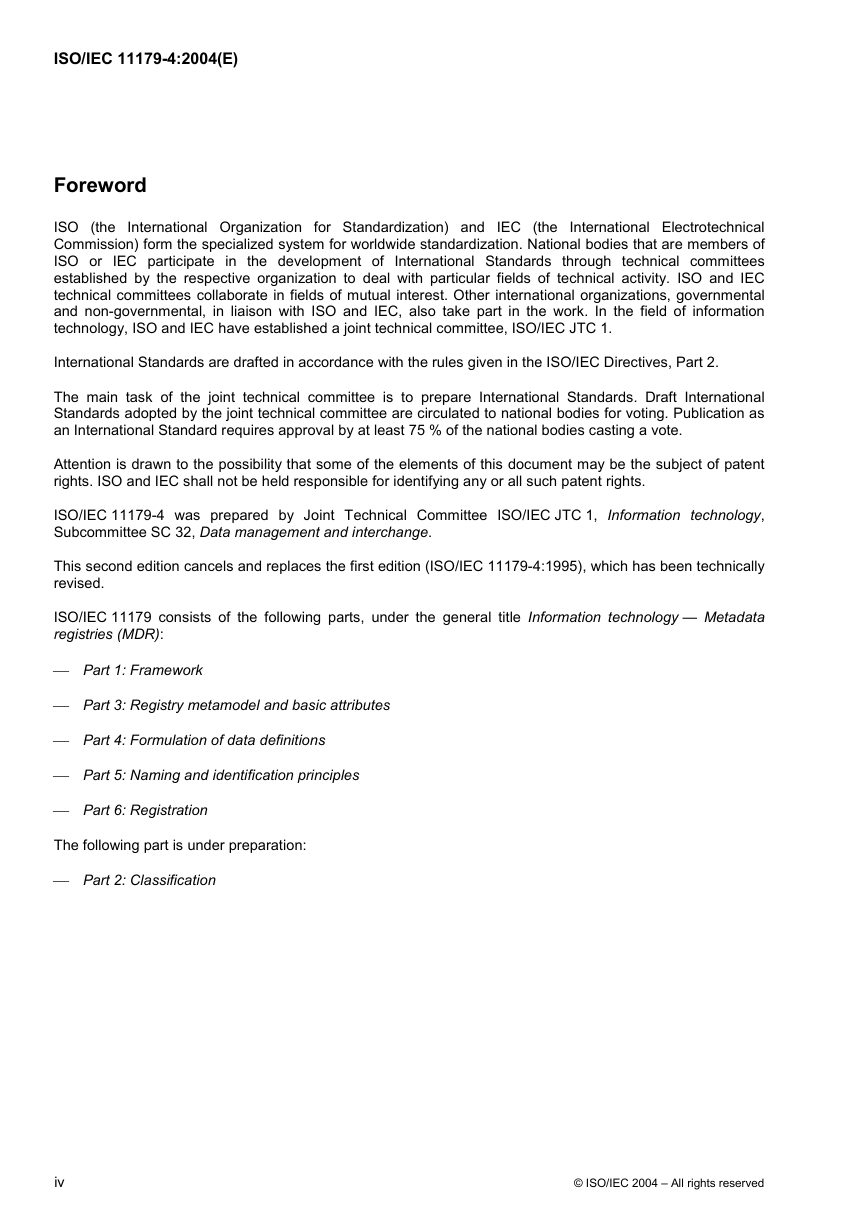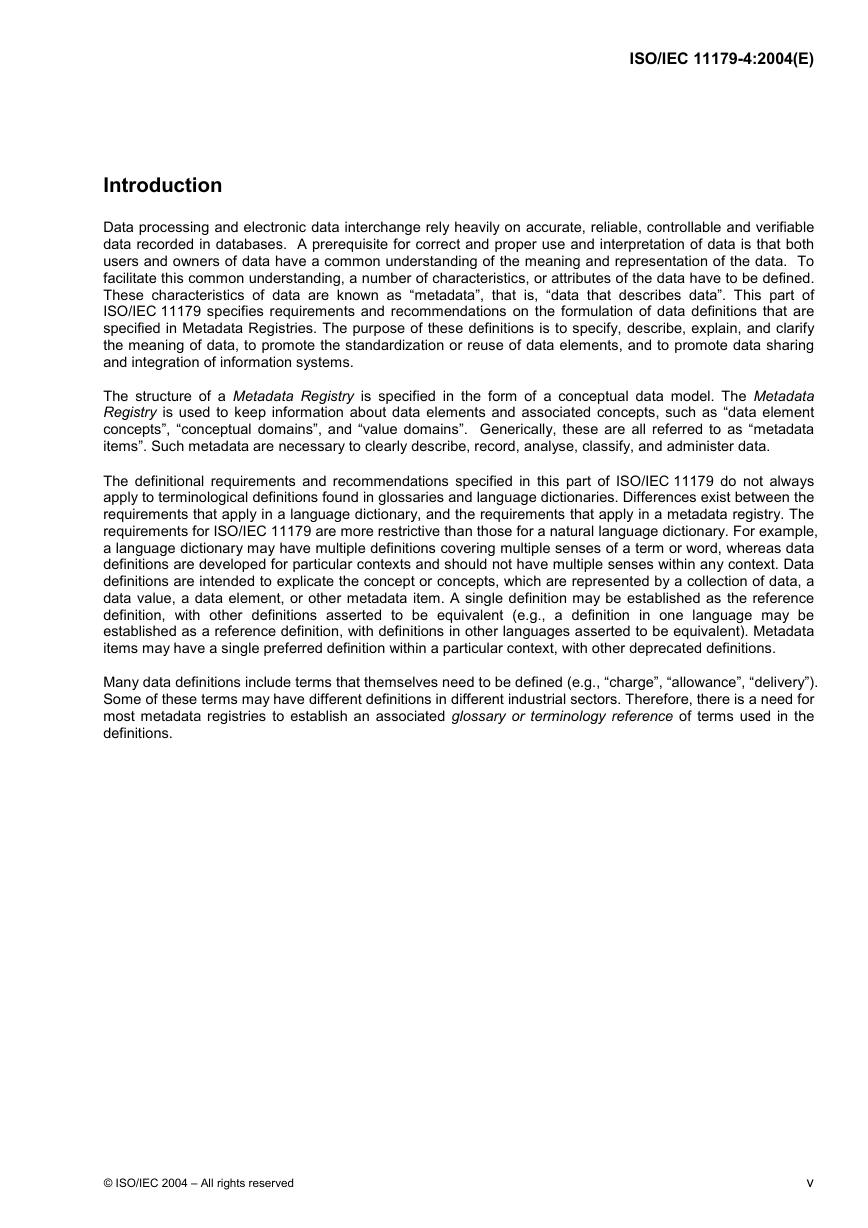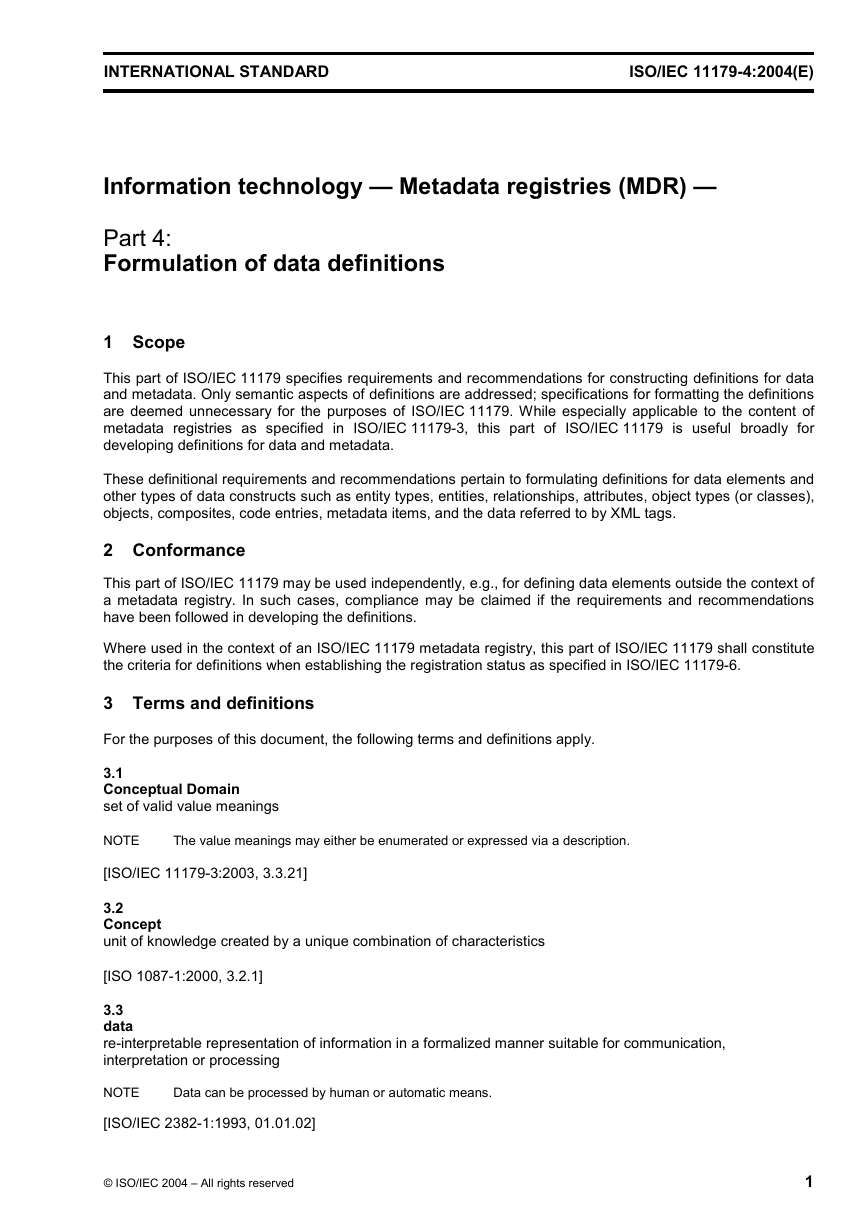INTERNATIONAL
STANDARD
ISO/IEC
11179-4
Second edition
2004-07-15
Information technology — Metadata
registries (MDR) —
Part 4:
Formulation of data definitions
Technologies de l'information — Registres de métadonnées (RM) —
Partie 4: Formulation des définitions de données
Reference number
ISO/IEC 11179-4:2004(E)
© ISO/IEC 2004
�
ISO/IEC 11179-4:2004(E)
PDF disclaimer
This PDF file may contain embedded typefaces. In accordance with Adobe's licensing policy, this file may be printed or viewed but
shall not be edited unless the typefaces which are embedded are licensed to and installed on the computer performing the editing. In
downloading this file, parties accept therein the responsibility of not infringing Adobe's licensing policy. The ISO Central Secretariat
accepts no liability in this area.
Adobe is a trademark of Adobe Systems Incorporated.
Details of the software products used to create this PDF file can be found in the General Info relative to the file; the PDF-creation
parameters were optimized for printing. Every care has been taken to ensure that the file is suitable for use by ISO member bodies. In
the unlikely event that a problem relating to it is found, please inform the Central Secretariat at the address given below.
© ISO/IEC 2004
All rights reserved. Unless otherwise specified, no part of this publication may be reproduced or utilized in any form or by any means,
electronic or mechanical, including photocopying and microfilm, without permission in writing from either ISO at the address below or
ISO's member body in the country of the requester.
ISO copyright office
Case postale 56 • CH-1211 Geneva 20
Tel. + 41 22 749 01 11
Fax + 41 22 749 09 47
E-mail copyright@iso.org
Web www.iso.org
Published in Switzerland
ii
© ISO/IEC 2004 – All rights reserved
�
ISO/IEC 11179-4:2004(E)
Contents
Page
Foreword............................................................................................................................................................ iv
Introduction ........................................................................................................................................................ v
Scope...................................................................................................................................................... 1
1
Conformance ......................................................................................................................................... 1
2
Terms and definitions........................................................................................................................... 1
3
Summary of data definition requirements and recommendations .................................................. 3
4
Requirements ........................................................................................................................................ 3
4.1
Recommendations ................................................................................................................................ 3
4.2
Provisions.............................................................................................................................................. 4
5
Premises ................................................................................................................................................ 4
5.1
Requirements ........................................................................................................................................ 4
5.2
Recommendations ................................................................................................................................ 6
5.3
Bibliography ....................................................................................................................................................... 9
© ISO/IEC 2004 – All rights reserved
iii
�
ISO/IEC 11179-4:2004(E)
Foreword
ISO (the International Organization for Standardization) and IEC (the International Electrotechnical
Commission) form the specialized system for worldwide standardization. National bodies that are members of
ISO or IEC participate in the development of International Standards through technical committees
established by the respective organization to deal with particular fields of technical activity. ISO and IEC
technical committees collaborate in fields of mutual interest. Other international organizations, governmental
and non-governmental, in liaison with ISO and IEC, also take part in the work. In the field of information
technology, ISO and IEC have established a joint technical committee, ISO/IEC JTC 1.
International Standards are drafted in accordance with the rules given in the ISO/IEC Directives, Part 2.
The main task of the joint technical committee is to prepare International Standards. Draft International
Standards adopted by the joint technical committee are circulated to national bodies for voting. Publication as
an International Standard requires approval by at least 75 % of the national bodies casting a vote.
Attention is drawn to the possibility that some of the elements of this document may be the subject of patent
rights. ISO and IEC shall not be held responsible for identifying any or all such patent rights.
ISO/IEC 11179-4 was prepared by Joint Technical Committee ISO/IEC JTC 1, Information technology,
Subcommittee SC 32, Data management and interchange.
This second edition cancels and replaces the first edition (ISO/IEC 11179-4:1995), which has been technically
revised.
ISO/IEC 11179 consists of the following parts, under the general title Information technology — Metadata
registries (MDR):
Part 1: Framework
Part 3: Registry metamodel and basic attributes
Part 4: Formulation of data definitions
Part 5: Naming and identification principles
Part 6: Registration
The following part is under preparation:
Part 2: Classification
iv
© ISO/IEC 2004 – All rights reserved
�
ISO/IEC 11179-4:2004(E)
Introduction
Data processing and electronic data interchange rely heavily on accurate, reliable, controllable and verifiable
data recorded in databases. A prerequisite for correct and proper use and interpretation of data is that both
users and owners of data have a common understanding of the meaning and representation of the data. To
facilitate this common understanding, a number of characteristics, or attributes of the data have to be defined.
These characteristics of data are known as “metadata”, that is, “data that describes data”. This part of
ISO/IEC 11179 specifies requirements and recommendations on the formulation of data definitions that are
specified in Metadata Registries. The purpose of these definitions is to specify, describe, explain, and clarify
the meaning of data, to promote the standardization or reuse of data elements, and to promote data sharing
and integration of information systems.
The structure of a Metadata Registry is specified in the form of a conceptual data model. The Metadata
Registry is used to keep information about data elements and associated concepts, such as “data element
concepts”, “conceptual domains”, and “value domains”. Generically, these are all referred to as “metadata
items”. Such metadata are necessary to clearly describe, record, analyse, classify, and administer data.
The definitional requirements and recommendations specified in this part of ISO/IEC 11179 do not always
apply to terminological definitions found in glossaries and language dictionaries. Differences exist between the
requirements that apply in a language dictionary, and the requirements that apply in a metadata registry. The
requirements for ISO/IEC 11179 are more restrictive than those for a natural language dictionary. For example,
a language dictionary may have multiple definitions covering multiple senses of a term or word, whereas data
definitions are developed for particular contexts and should not have multiple senses within any context. Data
definitions are intended to explicate the concept or concepts, which are represented by a collection of data, a
data value, a data element, or other metadata item. A single definition may be established as the reference
definition, with other definitions asserted to be equivalent (e.g., a definition in one language may be
established as a reference definition, with definitions in other languages asserted to be equivalent). Metadata
items may have a single preferred definition within a particular context, with other deprecated definitions.
Many data definitions include terms that themselves need to be defined (e.g., “charge”, “allowance”, “delivery”).
Some of these terms may have different definitions in different industrial sectors. Therefore, there is a need for
most metadata registries to establish an associated glossary or terminology reference of terms used in the
definitions.
© ISO/IEC 2004 – All rights reserved
v
�
�
INTERNATIONAL STANDARD
ISO/IEC 11179-4:2004(E)
Information technology — Metadata registries (MDR) —
Part 4:
Formulation of data definitions
1 Scope
This part of ISO/IEC 11179 specifies requirements and recommendations for constructing definitions for data
and metadata. Only semantic aspects of definitions are addressed; specifications for formatting the definitions
are deemed unnecessary for the purposes of ISO/IEC 11179. While especially applicable to the content of
metadata registries as specified in ISO/IEC 11179-3, this part of ISO/IEC 11179 is useful broadly for
developing definitions for data and metadata.
These definitional requirements and recommendations pertain to formulating definitions for data elements and
other types of data constructs such as entity types, entities, relationships, attributes, object types (or classes),
objects, composites, code entries, metadata items, and the data referred to by XML tags.
2 Conformance
This part of ISO/IEC 11179 may be used independently, e.g., for defining data elements outside the context of
a metadata registry. In such cases, compliance may be claimed if the requirements and recommendations
have been followed in developing the definitions.
Where used in the context of an ISO/IEC 11179 metadata registry, this part of ISO/IEC 11179 shall constitute
the criteria for definitions when establishing the registration status as specified in ISO/IEC 11179-6.
3 Terms and definitions
For the purposes of this document, the following terms and definitions apply.
3.1
Conceptual Domain
set of valid value meanings
NOTE
The value meanings may either be enumerated or expressed via a description.
[ISO/IEC 11179-3:2003, 3.3.21]
3.2
Concept
unit of knowledge created by a unique combination of characteristics
[ISO 1087-1:2000, 3.2.1]
3.3
data
re-interpretable representation of information in a formalized manner suitable for communication,
interpretation or processing
NOTE
Data can be processed by human or automatic means.
[ISO/IEC 2382-1:1993, 01.01.02]
© ISO/IEC 2004 – All rights reserved
1
�
ISO/IEC 11179-4:2004(E)
3.4
data element
unit of data for which the definition, identification, representation and permissible values are specified by
means of a set of attributes
[ISO/IEC 11179-3:2003, 3.3.36]
3.5
Data Element Concept
concept that can be represented in the form of a data element, described independently of any particular
representation
[ISO/IEC 11179-3:2003, 3.3.38]
3.6
definition
representation of a concept by a descriptive statement which serves to differentiate it from related concepts
[ISO 1087-1:2000, 3.3.1]
3.7
metadata
data that defines and describes other data
[ISO 1087-1:2000, 3.2.18]
3.8
Metadata Registry
information system for registering metadata
[ISO/IEC 11179-3:2003, 3.2.22]
3.9
metadata item
instance of a metadata object
NOTE 1
In all parts of ISO/IEC 11179, this term is applied only to instances of metadata objects described by the
metamodel in Clause 4 of ISO/IEC 11179-3:2003. Examples include instances of data elements, data element concepts,
permissible values, etc.
NOTE 2
A metadata item has associated attributes, as appropriate for the metadata object it instantiates.
[ISO/IEC 11179-3:2003, 3.2.19]
3.10
metadata object
object type defined by a metamodel
NOTE
In all parts of ISO/IEC 11179, this term is applied only to metadata objects described by the metamodel in
Clause 4 of ISO/IEC 11179-3:2003. Examples include data elements, data element concepts, permissible values etc. See
Clause 3.3 of ISO/IEC 11179-3:2003 for a complete list.
[ISO/IEC 11179-3:2003, 3.2.20]
3.11
name
designation of an object by a linguistic expression
[ISO/IEC 11179-3:2003, 3.2.26]
2
© ISO/IEC 2004 – All rights reserved
�
















 2023年江西萍乡中考道德与法治真题及答案.doc
2023年江西萍乡中考道德与法治真题及答案.doc 2012年重庆南川中考生物真题及答案.doc
2012年重庆南川中考生物真题及答案.doc 2013年江西师范大学地理学综合及文艺理论基础考研真题.doc
2013年江西师范大学地理学综合及文艺理论基础考研真题.doc 2020年四川甘孜小升初语文真题及答案I卷.doc
2020年四川甘孜小升初语文真题及答案I卷.doc 2020年注册岩土工程师专业基础考试真题及答案.doc
2020年注册岩土工程师专业基础考试真题及答案.doc 2023-2024学年福建省厦门市九年级上学期数学月考试题及答案.doc
2023-2024学年福建省厦门市九年级上学期数学月考试题及答案.doc 2021-2022学年辽宁省沈阳市大东区九年级上学期语文期末试题及答案.doc
2021-2022学年辽宁省沈阳市大东区九年级上学期语文期末试题及答案.doc 2022-2023学年北京东城区初三第一学期物理期末试卷及答案.doc
2022-2023学年北京东城区初三第一学期物理期末试卷及答案.doc 2018上半年江西教师资格初中地理学科知识与教学能力真题及答案.doc
2018上半年江西教师资格初中地理学科知识与教学能力真题及答案.doc 2012年河北国家公务员申论考试真题及答案-省级.doc
2012年河北国家公务员申论考试真题及答案-省级.doc 2020-2021学年江苏省扬州市江都区邵樊片九年级上学期数学第一次质量检测试题及答案.doc
2020-2021学年江苏省扬州市江都区邵樊片九年级上学期数学第一次质量检测试题及答案.doc 2022下半年黑龙江教师资格证中学综合素质真题及答案.doc
2022下半年黑龙江教师资格证中学综合素质真题及答案.doc